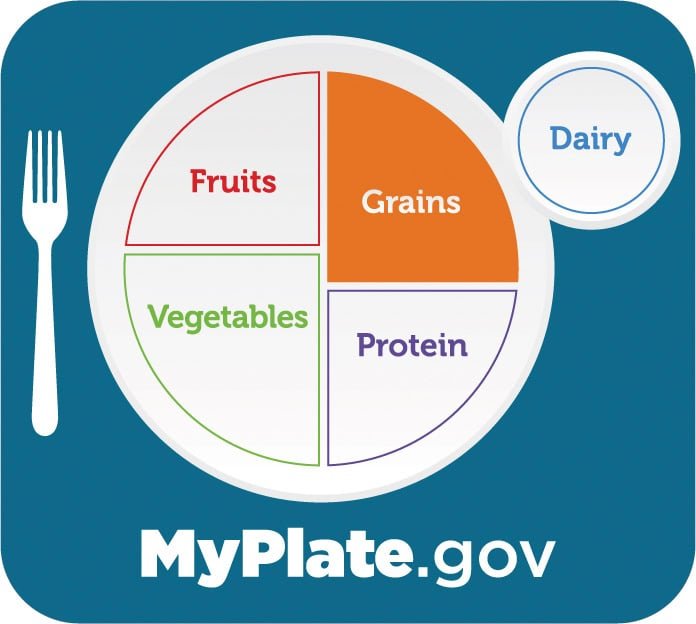
The American Diet, Health Care, and Big Government
Cardinal Team
American Life Spans Are Shorter Than They Should Be
Of the 37 richest countries in the Organization for Economic Cooperation and Development (OECD), the U.S ranks 28th in life expectancy. This is far behind the top three nations: Japan (84.4 years), Spain (84.0), and Switzerland (84.0). If the United States of America is the richest nation in the world, why does it rank so poorly? While your first guess may be our healthcare system, the real answer is the American diet.
The Standard American Diet is Unhealthy
According to the United States Department of Agriculture (USDA) Dietary Guidelines for Americans, the standard American diet (SAD) is too low in fresh fruits and vegetables, whole grains, lean protein, and healthy oils. It is also too high in red meat, high-fat dairy, processed foods, refined carbohydrates, added sugars, salt, and calories.
Below is a visualization of the dietary guideline.

Humans were hunter-gatherers on a high protein, plant-complemented diet for thousands of years. Now, in the 21st century, you can find a McDonald’s in nearly every corner of American cities and towns. Consequently, we face the “diseases of civilization.”
The Standard American Diet Makes Health Care More Expensive
This phrase comes from scientific evidence that our diets have led to acne, obesity, diabetes, heart disease, and possibly cancer. Due to these discoveries, new diet fads have emerged: the Paleo Diet, the Garden of Eden Diet, and the Pacific Island Diet, to name a few. But what impact does this have on the American healthcare system?
According to a study released in 2019, unhealthy diets account for 20% of U.S. health care costs, covering a range of illnesses such as heart disease, strokes, and diabetes. Researchers of the study found that the annual economic burden of health care expenses from cardiometabolic diseases adds up to roughly $300 per person or $50 billion nationally.
The Healthcare System Can’t Give You Good Health
Thus, a new age of health care has emerged: conflating health care and good health. Despite achievements in medical technology and medicine, health care is only a small factor in determining American life spans. But, health care debates across the nation focus on the importance of the system, subsidizing all health care services universally. The definition of a health “need” has continued to grow in response.
The encapsulating language, found only in health care, has failed to recognize medical advancements that have undoubtedly improved American quality of life. Yet, health care’s lack of balance and protection by the U.S. government has broken our nation’s health system. Let me provide a non-health care example.
Price Transparency & Free Markets
Let’s consider TVs; how much did you pay for your last TV? According to a variety of tech gurus, an average TV can be purchased for $450. Expensive? Absolutely. But let’s take a look at the first TV. In the 1930s, the cheapest TV with a 12-inch screen was $445, equivalent to $8,567 today. Owning a TV was a signal of wealth in America. Today, almost every household in America has a black screen sitting in their living room. Technology has continued to develop and become more affordable since the 1930s. So, why isn’t the same true for health care?
Government Interference Makes Health Care More Expensive
Most researchers agree that technology has contributed to rising health care costs. But, thanks to government mandates, this is only true when insurance is involved in health care payments. Because the patient doesn’t pay directly, insurance and providers are permitted to negotiate prices that are insulated from a competitive market.
LASIK surgery is considered an elective surgery, an example of a service not covered by many insurance plans. According to the Refractive Surgery Council, LASIK cost roughly $4,000 in 2008 (A little over $5,000 in 2021). Today, it averages at $4,400, a 20% reduction in price. Paired with today’s average hourly wage increase of 40% over the same period, LASIK is now much more affordable.
LASIK operates in a free-market, direct pay system. Rather than pesky insurance getting in the way, LASIK providers compete with one another. They cut prices toward the lower marginal costs. Manufacturers respond by lowering the prices of the technologies purchased to provide care.
Because the U.S. government and insurance companies subsidize the healthcare system, it is unable to enjoy the normal competitive pressures from the free market. Without the ability to acknowledge prices, prices have a hard time doing their job correctly.
Fix The American Diet. Get Government Out of Health Care. Put Patients First.
So, how did we go from the American diet to the cost of LASIK? Our system of health care substitutes insurance for the primary patient, leading to systems that serve institutional needs over American health. Focusing on the institution continues to substitute patients with third party payers. This has led to an expansion of what is “needed” in health care. Government is focusing on subsidizing the healthcare system instead of causes that actually improve American health. Health care costs would be more affordable if patients paid directly and prices were transparent. Then, market forces could act properly on costs and providers.
Current healthcare systems are not held to patient standards and operate away from sound economic principles, equating quantity and quality in health care. Instead we should fund public health campaigns, vaccination, better diets, and other preventive health services that have the ability to solve many of today’s health issues. To improve health, save costs, and reform the dependence on the government in health, patients must be in the driver’s seat.
Jessica Dobrinsky is a Policy Analyst for the Cardinal Institute for West Virginia Policy.







